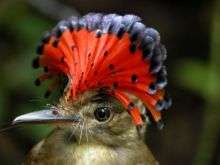Why do birds migrate?

Why do some birds fly thousands of miles back and forth between breeding and non-breeding areas every year whereas others never travel at all?
One textbook explanation suggests either eating fruit or living in non-forested environments were the precursors needed to evolve migratory behavior.
Not so, report a pair of ecologists from The University of Arizona in Tucson. The pressure to migrate comes from seasonal food scarcity.
"It's not just whether you eat insects, fruit, nectar or candy bars or where you eat them -- it matters how reliable that food source is from day-to-day," said W. Alice Boyle. "For example, some really long-distance migrants like arctic terns are not fruit-eaters."
Boyle, an adjunct lecturer in UA's department of ecology and evolutionary biology and co-author Courtney J. Conway, a UA assistant professor of natural resources and a research scientist with the U.S. Geological Survey, report their findings in the March 2007 issue of American Naturalist.
To figure out the underlying pressures that drive some birds to leave home for the season, the team wanted to examine a related set of species and compare their size, food type, habitat, migratory behavior and whether they fed in flocks.
Boyle and Conway focused on 379 species of New World flycatchers from the suborder Tyranni. One of the largest groups of New World birds, the Tyranni includes kingbirds, flycatchers, phoebes and such southern Arizona birdwatchers' delights as vermillion flycatchers and rose-throated becards. Tropical members include manakins and cotingas.
First the scientists had to construct the first "supertree" for New World flycatchers.
"No one has ever compiled all those birds together into one megafamily tree," Boyle said, adding that "supertree" is a technical term among evolutionary biologists.
Having the tree let the researchers compare a variety of traits across the many species of Tyranni by using a computer analysis called phylogenetic independent contrasts.
The technique allowed the scientists to sort out whether a bird was migratory because that's what species on their side of the family tree always did or whether the bird's travel habits had some ecological correlates.
Food scarcity was the number one issue that predicted a species' migratory behavior, the team found. Boyle said, "Food availability is the underlying process, not diet and habitat."
One strategy for dealing seasonal changes in food availability is migration. The team also found that species that forage in flocks are less likely to migrate.
"If you are faced with food scarcity, you have two options," Boyle said. "You can either forage with other birds or you can migrate."
When birds band together to search for food, the group is more likely to find a new patch of food than is one lone individual, she said. "Flocking can be an alternative way to deal with food shortages."
A universal assumption about bird migration has been that short-distance migration is an evolutionary stepping stone to long-distance migration. The team's work contradicts that idea by showing that short-distance migrants are inherently different from their globe-trotting cousins.
Source: University of Arizona
















